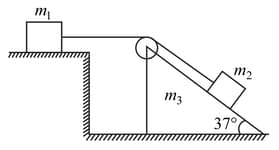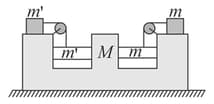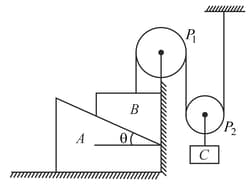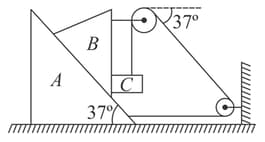In the arrangement shown in the figure, a wedge of mass is placed on a smooth horizontal surface. A small and light pulley is connected on its top edge as shown. A light flexible thread passes over the pulley. Two blocks having mass and are connected at the ends of the thread. is on smooth horizontal surface and rests on inclined surface of the wedge. Base length of the wedge is and inclination is is initially near the top edge of the wedge. If the whole system is released from rest. Calculate:

(i) velocity of wedge when reaches its bottom
(ii) velocity of at that instant and tension in the thread during motion of . All the surfaces are smooth

(ii) velocity of at that instant and tension in the thread during motion of . All the surfaces are smooth

Important Questions on Laws of Motion
Neglecting friction every where, find the acceleration of . Assume .

In the figure shown and are massless pulleys. is fixed and can move. Masses of and are and , respectively. All contacts are smooth and the string is massless. . Find the acceleration of block in .

A system is shown in the figure. All contact surfaces are smooth and string is tight and inextensible. Wedge moves towards right with speed and velocity of relative to is in downward direction along the incline having magnitude . Find the horizontal and vertical components of the velocity of block .

An object of mass is placed at rest in a frame moving with velocity and having acceleration . This object is also seen by an observer standing in a frame moving with velocity .
(i) Calculate ‘Pseudo force’ acting on object. Which frame is responsible for this force.
(ii) Calculate net force acting on object with respect to frame.
(iii) Calculate net force acting on object with respect to frame.
In the figure shown, the blocks are pulled down with constant velocities . Find the acceleration of block .

A system is shown in the figure. Assume that cylinder remains in contact with the two wedges. Find the velocity of cylinder.

In the figure shown, a person pulls a light string with a constant speed . The other end of the string is tied to a very small block which moves on a smooth horizontal surface. The block is initially situated at a distance from the pulley which is very large in comparison to . Find the angle when the block leaves the surface. Take .

A box having mass is to slowly slide through on a horizontal straight track having friction coefficient with the box.
(a) Find the work done by the person pulling the box with a rope at an angle with the horizontal.
(b) Find the work when the person has chosen a value of which ensures him the minimum magnitude of the force.
